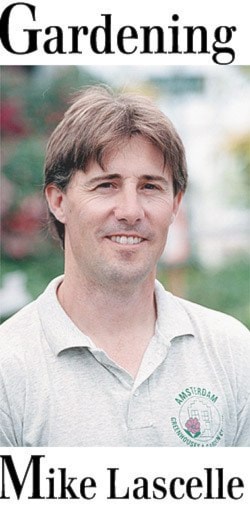Strangely enough, most of the things that I’m allergic to come from the 1970s.
For example, put me anywhere near a tuna casserole, a Neil Diamond song (particularly Sweet Caroline), reruns of The Love Boat or circa 1975-80, AMC Pacers – and suddenly, I break out in a rash and swell up like a balloon.
Fortunately, I am quite capable of avoiding these minor annoyances, while those people with real allergies often struggle with serious physical symptoms while also trying to diagnose the numerous factors that can trigger them.
Gardens, or the plants in them, are often the culprits. The botanical factors which might aggravate allergic symptoms include fine hairs (indumentum) on the foliage of London Plane trees (Platanus), pollen clouds wafting off male plants such as Taxus x media ‘Brownii’ and even the strong perfume or fragrance of honeysuckle (Lonicera).
Then there are those garden plants that commonly cause dermal reactions, such as Euphorbia (with its milky sap), prickly junipers and rue (Ruta).
While the latter problem is easily resolved by wearing gloves when handling these plants, what do you do for more dynamic and harder to control factors, such as air-borne pollen?
Thankfully, an allergen rating system for plants has been established based on 70 different factors – some of which include flower size, method of pollination (wind or insect-borne pollen), fragrance, individual pollen structure, the plant family and the length of the pollination period.
It is referred to as the OPALS (Ogren Plant Allergy Scale) scale and this system was developed by Thomas Ogren (MS Agriculture) who began the process by asking himself two basic questions: What do plants that are known not to cause allergies have in common with each other; and, what do plants that are well known to cause allergies have in common?
The resulting system was favourably peer-reviewed by botanists and allergists, and eventually adopted by the USDA (US Department of Agriculture) to create allergy ratings for plant material used in all major US cities.
The OPALS scale works on a simple one to 10 numerical rating, with one being the lowest allergen level and 10 being plants that almost always cause allergic reactions.
A sampling of rated plants from best to worst for allergies would include Acer rubrum ‘October Glory’ (1), single hollyhocks (Alcea 3), Abelia (5), Buxus or boxwood (7) and male mulberry (Morus) trees (10).
Take note that some of the worst offenders are male selections of dioecious plants (with male and female flowers on separate plants) that had been used extensively in the past because they produce no messy fruit, unfortunately what they do emit are clouds of air-borne pollen.
You should also be looking to choose disease-resistant plants (particularly roses), as the spores from fungal infections such as rust, black spot and powdery mildew can also trigger allergies.
I recently had a design customer request to keep all the selections for her new garden strictly to low-allergen plants – which meant I had to do a little research. My first assumption that foliar plants would be less allergic turned out to be wrong, as the aforementioned boxwood produces copious amounts of pollen when not constantly pruned.
Similarly, there are many floriferous plants such as flowering quince (Chaenomeles) and purple-leaf plum (Prunus cerasifera ‘Pissardii Nigra’) that rate quite low on the OPALS scale.
To give you some idea of what would be appropriate for a low-allergen garden, here is a short list of plants that rate less than four on the OPALS scale:
• Shrubs: heavenly bamboo (Nandina), Mexican orange (Choisya), Oregon grape (Mahonia), Camellia, mophead hydrangea (H. macrophylla), Potentilla, strawberry bush (Arbutus unedo).
• Perennials: black-eyed Susan (Rudbeckia), cape fuchsia (Phygelius), lilyturf (Liriope), bergenia, daylily (Hemerocallis), Iris, hens and chicks, columbine (Aquilegia), lupine, sea thrift (Armeria), Heuchera, blue star creeper (Isotoma), sunrose (Helianthemum), hardy geranium.
• Summer flowers: zinnia, lobelia, impatiens, begonia, snapdragon, petunia, coleus.
• Bulbs: tulip, daffodil, canna lily, grape hyacinth (Muscari), gladiolus, windflower (Anemone).
For a more comprehensive listing (albeit southern California focussed), visit www.asthmasandiego.org (click resources, then low allergy plants- full list) or look for Mr. Ogren’s book, Allergy-Free Gardening (Ten Speed Press, 2004).
I’ve uploaded a new story, Buy a Cheap Garden Tool ... Kill a Coral Reef, to my garden blog at www.soulofagardener.wordpress.com – I hope it inspires you to carefully consider your next tool purchase.
Mike Lascelle is a local nursery manager and gardening author. Email him at hebe_acer@hotmail.com and visit his blog Soul of a Gardener .
